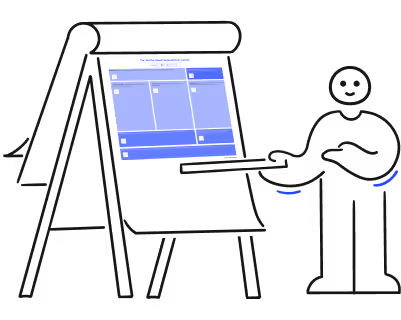Leadership in the workplace: an essential skill to develop

Empower your organization with the skills-based canvas.

Leadership is an admired and respected quality. It can be defined in many ways, but most people agree that it encompasses qualities such as intelligence, charisma, integrity and empathy.
However, leadership is much more than these qualities!
It is an approach, a vision and a value set that guide others in their actions and interactions.
Leadership is a key element of your company’s success. It involves everyone, managers to team members alike.
So, how can you develop leaders in your team?
What is leadership?
Leadership in the workplace is about developing the qualities in our employees that enable them to effectively motivate and guide others. Good leaders are essential in your organization because they help create a common vision and purpose that employees can rally around.
However, it is wrong to believe that only managers and bosses can be leaders.
Leadership is present at all levels of an organization, and employee leadership is very important. Fostering and encouraging intrapreneurship in your company by valuing employee leadership and initiative is a huge step forward.
In order to develop employee leadership, it is important to offer them learning and development opportunities.
Transformational leadership is “in”
What is transformational leadership?
Unlike transactional leadership, transformational leadership is based more on one’s positive influence.
In order to achieve their goals, a transformational leader will:
- Encourage others to go beyond their limits, by caring about them;
- Maintain a pleasant and positive work atmosphere;
- Share an inspiring vision;
- Acknowledge the importance of everyone’s contribution in the company.
Rather than being based on a transactional approach between the company and its employees, this approach aims to:
- Encourage the development of employee autonomy;
- Foster professional and personal development for all company members;
- Acknowledge the importance of everyone’s daily tasks.
Therefore, transformational leadership is about believing that happy, fulfilled employees are far more productive and engaged than employees who work under the constant pressure of having to perform.
What are the qualities of a real leader?
It’s no news that a leader is not necessarily someone in a position of authority. True leaders are found both among your employees and your managers.
Their leadership is simply being expressed differently.
Obviously, a leader’s qualities can vary depending on the situation. Nevertheless, a leader must demonstrate certain key qualities in order to inspire and guide others, such as:
- Intelligence;
- The ability to take decisions;
- Being organized;
- Courage;
- Charisma;
- Integrity;
- Communication skills;
- Empathy.
Why are good leaders so important?
Good leaders are important because they share clear direction, they motivate and inspire others.
They help employees feel connected to a common goal and create a feeling of belonging to a community within an organization. Furthermore, good leaders know how to delegate tasks and give employees the autonomy they need in order to be efficient in their work.
Finally, leaders play an important role in developing their employees’ talent. Through learning and development opportunities, leaders help their employees reach their potential and grow professionally.
Any organization in which people feel involved, respected and valued is bound to have more productive and successful employees.
Good leaders are essential to create this type of environment.
How to develop your employees’ leadership skills?
Here are some tips that would allow you to develop leadership within your team:
1. Encourage your employees to take on new challenges
Giving employees the chance to take on new projects will help them develop their accountability and leadership skills.
2. Listen to your employees
Encouraging employees to share their ideas and suggestions will allow you to get to know them better and understand how they think.
3. Set up a mentoring program
Mentoring programs are a great way to develop employee leadership skills.
By pairing experienced employees with junior employees, mentees can learn from their mentors’ successes and mistakes. Such programs also foster a sense of belonging while valuing mentors.
4. Set up a learning and training program
One of the most effective ways to develop your employees’ leadership is to offer them learning and development opportunities.
And that’s where a Learning Management System (LMS) comes in.
How can an LMS help cultivate leadership?
An LMS that caters to your needs is a valuable tool for developing leadership skills in the workplace.
By offering employees access to online courses, quizzes and other learning material, you allow them to develop the skills they need to become good leaders.
This type of training is particularly efficient because it allows employees to learn at their own pace and immediately get to apply what they have learnt.
An LMS can also track employee progress and provide feedback to help them improve their leadership skills. By giving employees access to leadership development resources and tracking their progress, you will be helping them become tomorrow’s leaders.
Leaders are important to any organization!
They can motivate employees to reach specific goals. In order to develop good leaders in the long run, one must take the time to offer managers and employees access to leadership training opportunities.
It’s a win-win, for employees and your company!
%20(1).png)

%20(1).avif)


.avif)
.avif)








